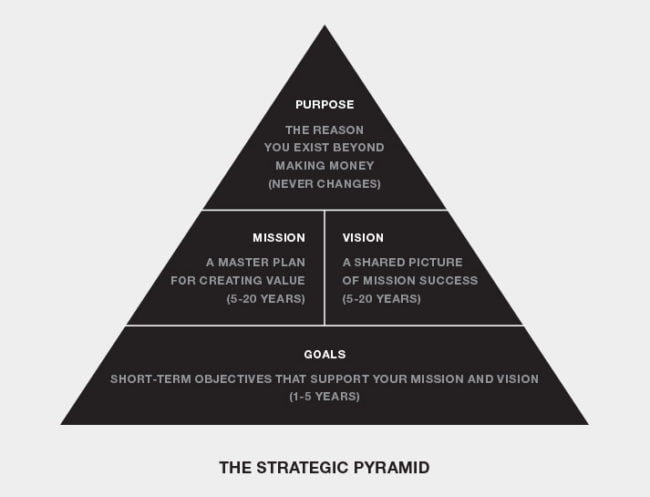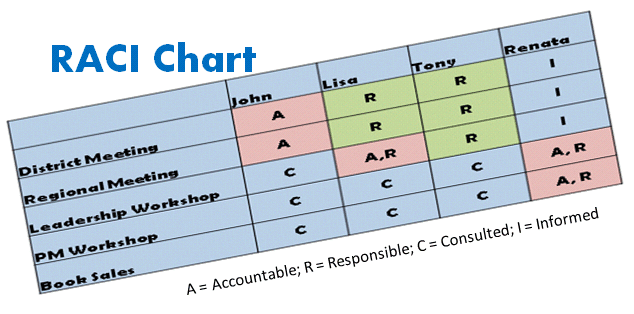Whether it is the end of the beginning of the year, or at any point in between, there is never a better time than now to review your business strategy. It is something that savvy executives do on a regular basis and can be prompted by a desire to check that things are evolving as they should for the business or an external factor such as a new competitor in the marketplace.
But what if your business does not feel like it has a strategy at all? Or do you want to throw out what you have got and start from scratch? There are plenty of models and consultants who can advise you on creating a successful business strategy for your company but, at a basic level, it is actually very simple. Here are some methods you might find useful:
The Strategy Pyramid
The strategy pyramid is a straightforward way of showing how your vision of the future can be turned into tangible deliverables. You start with where you want the company to go (and whole books have been written about creating visions, so we will not cover that today), translate that into concrete, and an achievable statement that becomes your strategy, and then build a portfolio to manage individual projects, each of which should be clearly linked to helping the company achieve its goals.
Work down the Strategy Pyramid
For the first pass, work down the strategy pyramid like this:
-
- Define your vision;
- Write a specific, measurable, achievable, realistic, and time-bound statement about what you are actually going to do to get there;
- Create a portfolio structure to manage the work: this simply means making sure that you have got oversight over all the initiatives that will help you achieve your strategy;
- Fit existing projects into the portfolio.
All your current work should fit into the portfolio either as business, usual tasks, or as projects. Map your projects onto the strategy – it should be obvious how each project is helping the company achieve its long-term goals.
Work up the Strategy Pyramid
For a comprehensive view of your new business strategy, it is also worth doing the exercise in reverse:
-
- Make a list of all your current projects and initiatives. Remember to talk to all business groups and divisions – there might be projects taking place outside of your direct sphere of control;
- Use a mind map tool like iMindQ to organize the projects into cohesive groups based on categories, objectives, or common resources;
- https://www.imindq.com/Turn these groupings into programs of work organized as a single business portfolio to give you oversight over all the initiatives.
This should give you a comprehensive view of all the work that is taking place. Think about the next level up on the strategy pyramid: does everything that is currently being worked on fit with where you want the business to go?
Doing the exercise in reverse can highlight projects that are being actively worked on but that do not really tie back into the overall strategy and vision for the organization.
Should you stop non-strategic projects?
Looking at your portfolio like this may uncover projects that do not align perfectly with your vision. So, should you cancel them?
This is a tricky question: if they are taking your business away from where you want to be, then possibly yes. For example, if you have decided that as an insurance company you are no longer going to develop your own software internally and you will buy packaged software, a small project to build a database might be non-strategic.
However, it could be tactical – solving a short-term need – and stopping it would not be sensible. You will have to consider each project on its merits taking into account:
-
- Its objectives;
- How far through the project lifecycle it is;
- Whether the deliverables will offer something tactically useful;
- What the remainder of the budget is – you do not necessarily want to invest a lot in something that is not strategic but remember not to take sunk costs into account when you are making the cancel/keep decision.
An empowered management team can put together a corporate strategy like this although, as I said, this is a very simple way of doing it and might not be appropriate for your business. Even so, I think you will find plenty of similarities between this and the more complicated methods.
Why not start small with this approach and build more complexity into your strategy model as time goes on? How did you define your strategy? Let us know in the comments.
About the author
Elizabeth Harrin is the author and award-winning blogger behind A Girl’s Guide To Project Management. Get her suggestions for being more productive at work on her blog.





